Physical Address
304 North Cardinal St.
Dorchester Center, MA 02124
Physical Address
304 North Cardinal St.
Dorchester Center, MA 02124
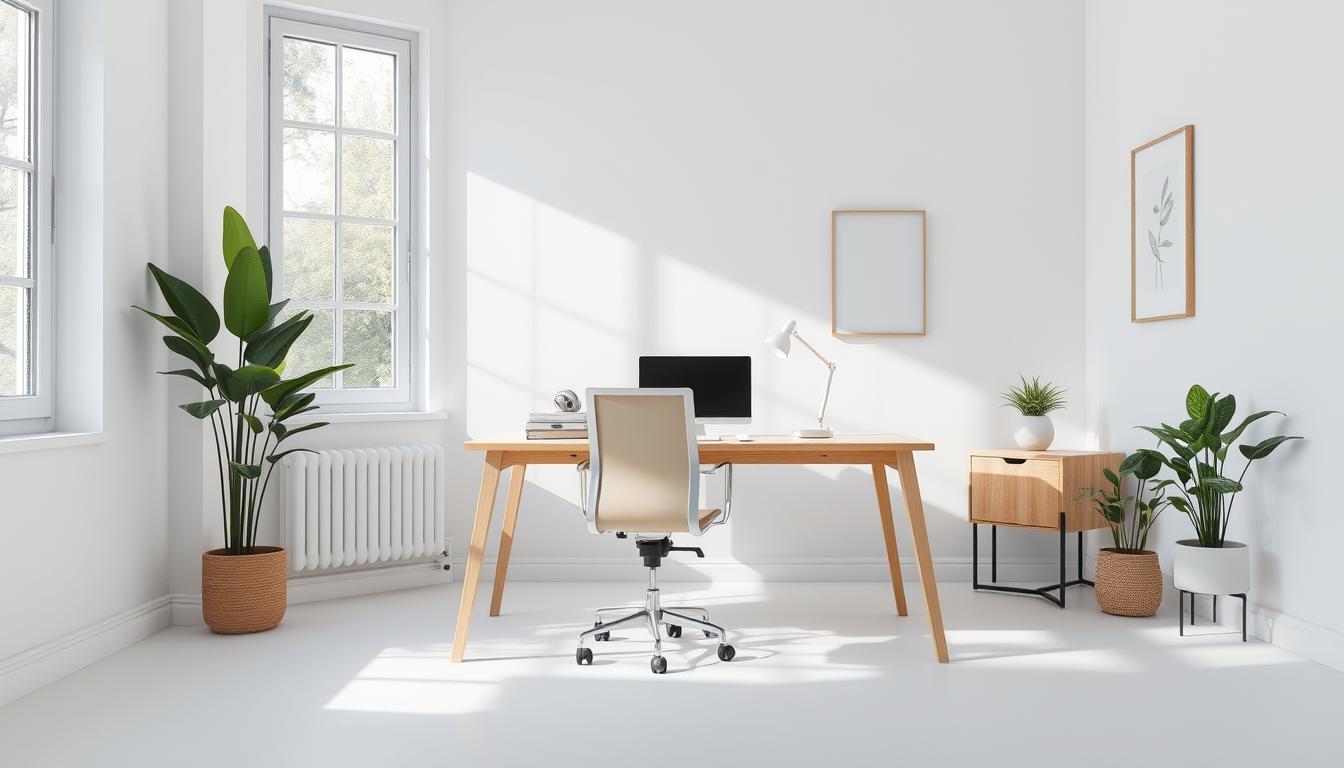
In a busy world, minimalist office ideas are key for a productive space. This design style focuses on simple, functional elements. It aims to remove clutter to help with focus and efficiency. With sleek furniture, natural light, and neutral colors, you create not just a workspace, but a place that enhances creativity and well-being.
Studies show that a minimal desk setup can boost creativity and clear the mind. Plus, minimalist home offices save money and space. This makes them a smart choice for maximizing your work area.
Minimalist office design focuses on simplicity and use. It’s about removing what you don’t need to make space neat and efficient. Clean lines and simple colors like white or grey are key. Features such as LED lights and charging docks are added without ruining the minimal look.
To keep a workspace clutter-free, minimalist design uses smart layouts. Desks arranged in clusters help use space well and keep things orderly. Even with simplicity, comfort is key. Options include leather chairs and sofas for a cozy work space.
Minimalist offices prefer modern, simple lighting. Using walls and partitions, areas are split without adding clutter. Colors are usually one shade, matching the company’s brand and setting a unique mood.
A successful minimalist design thinks carefully about function. It includes clutter-busting storage solutions, boosting office productivity. The design is user-friendly, with smart floor plans and tech built right in. This makes the office both productive and enjoyable.
To create a minimalist home office setup, focus on the essentials. Start by choosing a spot that’s quiet and has good light. The best spots help you stay focused, making work time more productive.
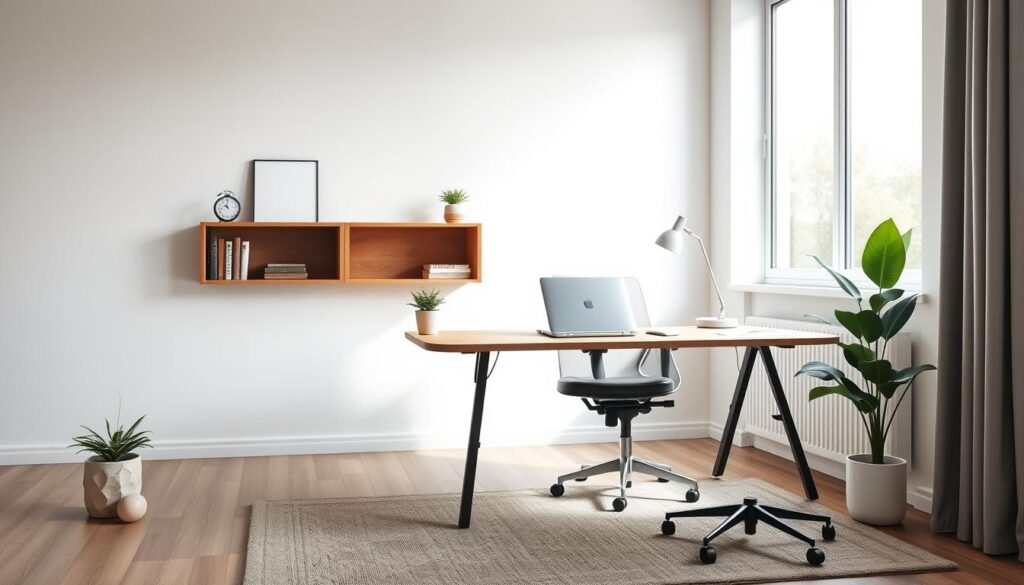
It’s important to measure your space before adding furniture. Putting your desk near a window uses natural light to boost energy and productivity. Make sure your office has room for an ergonomic chair and a desk. A comfy chair can cost less than $200, a good investment for your back.
Even minimalist offices might need to print, fax, or scan. You can find all-in-one gadgets for less than $50 from brands like HP. Using dual monitors can also help you work better. Or, try a standing desk like the Varidesk Basic 30 for its health perks.
To avoid a messy desk, use organizational tools. Shelves and drawer organizers keep things tidy. A leather desk pad looks nice and protects your desk.
Minimalist wall art can make your home office design look great and inspire you. Choose art that adds to your space without causing distractions.
Good lighting is key in a minimalist home office setup. Mix different types of light to get the mood just right. Using both natural and artificial light well can make a big improvement in your work.
Choosing the right colors for a minimalist office is key to a calm and focused environment. Neutral colors like white, gray, and beige create a calm setting. This boosts mental clarity and productivity. BEHR has great choices like Whipped Cream, Even Better Beige, and Tranquil Gray for minimalist design.
While white is a timeless option, adding shades with cool or warm undertones adds character. Beige and taupe bring warmth and coziness. This makes them great for living spaces and bedrooms.
Adding soft, muted accents like pale blues, greens, and blush pinks can enhance a minimalist look without overdoing it. For instance, muted tones like sage green and dusty blue add a natural vibe. This keeps the design simple and organic.
Using color thoughtfully can balance neutral and warm tones. Oatmeal shades are becoming popular, offering warmth without straying from minimalism. They go well with wood and linen. Adding monochromatic accents in varying shades keeps things sophisticated yet simple.
Warm minimalism is on the rise, with touches of yellow and red making spaces welcoming. Calming greens like forest and sage bring relaxation and depth. They’re great for a stress-free workspace.
With careful color choices, one can design a minimalist office that’s both efficient and inviting.
Choosing the right furniture is key in a minimalist office. It leads to a productive and efficient workspace. It also makes the office look good, works better, and supports good posture.
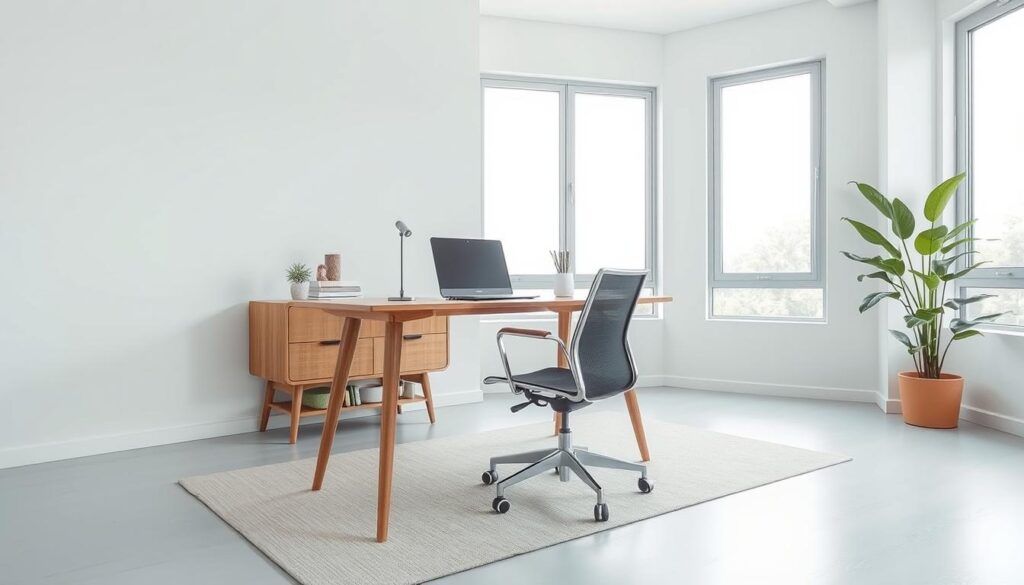
A desk is central in any office. For a minimalist space, desks should be small yet functional. They should not make the space feel crowded.
Choose desks with built-in storage like drawers or shelves. This helps keep things tidy. A floating or fold-out desk is great for saving space and keeping the area neat.
An ergonomic chair is vital in a minimalist office for comfort and health. It should allow adjustments in height, armrests, and back support. This ensures good posture and comfort.
Such a chair matches the simple style of a minimalist office. At the same time, it offers essential ergonomic benefits.
Getting the lighting right in a minimalist office is key for productivity. It’s not just about looks. Lighting affects your mood, energy, and how much you get done. Natural light plays a big role in minimalist spaces. It highlights simple designs and few pieces of furniture beautifully.
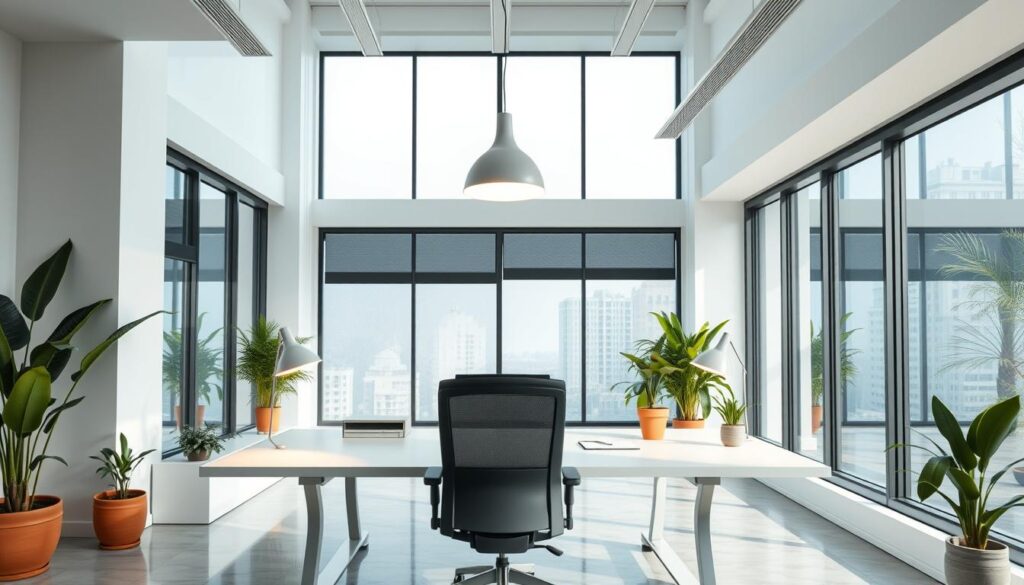
In minimalist offices, natural light is king. Using windows and skylights can boost office natural light. This reduces the need for electric lights during the day. It saves energy and makes the space bright and welcoming. This helps people focus better and work more efficiently.
Layering lights is smart in a minimalist office. Use ambient light for a soft background. Then add task lighting, like a desk lamp, for reading or writing. Pick lights that fit the minimalist look. Stay away from fancy fixtures as they can distract from the office’s simple design.
Smart lighting, like dimmers and sensors, really helps. They let you control the light level. This keeps the office well-lit anytime. Such adjustable lighting is a must in a minimalist space, where work and simplicity are top priorities.
Studies show that lighting can make a minimalist office 30% more productive. People working there feel less stressed and more focused. This shows how good lighting and a tidy workspace are great for our minds.
Decorating a minimalist office means adding simple elements that enhance the space. These elements should not create clutter. The goal is to make a calm area that helps with work and lessens distractions. Here are some tips to keep your office looking great and functional.
Adding plants can make a big difference in a minimalist office. Plants help clean the air and can make you feel better and work up to 15% better. Choose plants that are easy to care for, like snake plants, succulents, or spider plants. These plants do well inside with little attention.
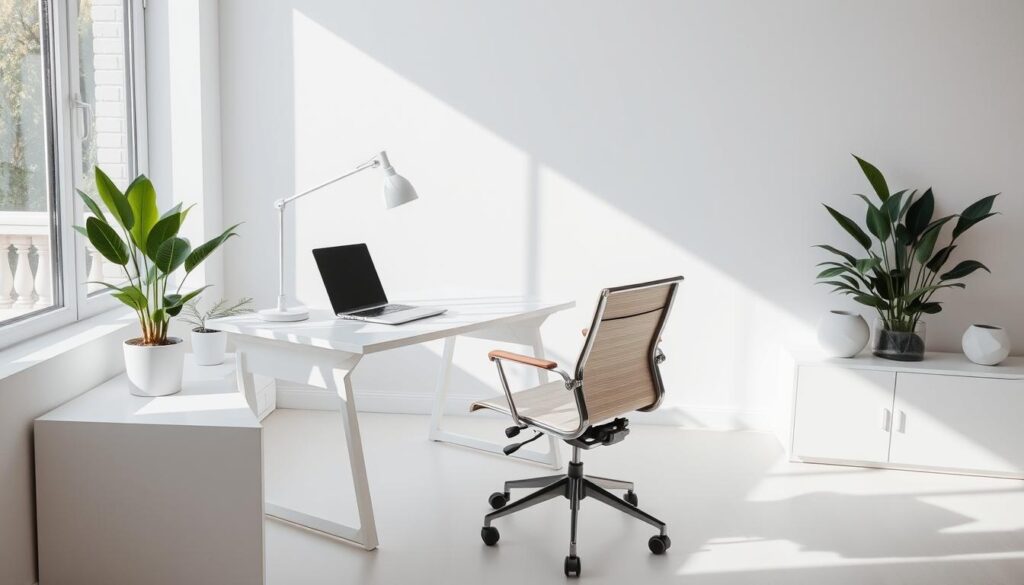
Adding personal items helps make an inspiring work area. Even with minimalist decor, you can add things like quotes, family photos, or simple art. These items should not take over the space. Use sleek frames for quotes or art to keep the minimalist look.
It’s all about the right mix of beauty and use. Select a few special items to make your space feel yours. Consider items that are both pretty and useful. Think about using stylish holders for pens, cool desk lamps, or neat shelves. These can offer storage and show off your chosen items.
In today’s fast-paced work setting, the advantages of minimalist office design shine through. Cost savings are a big plus. Fewer fixtures and furniture mean less spending, while maintaining a modern look.
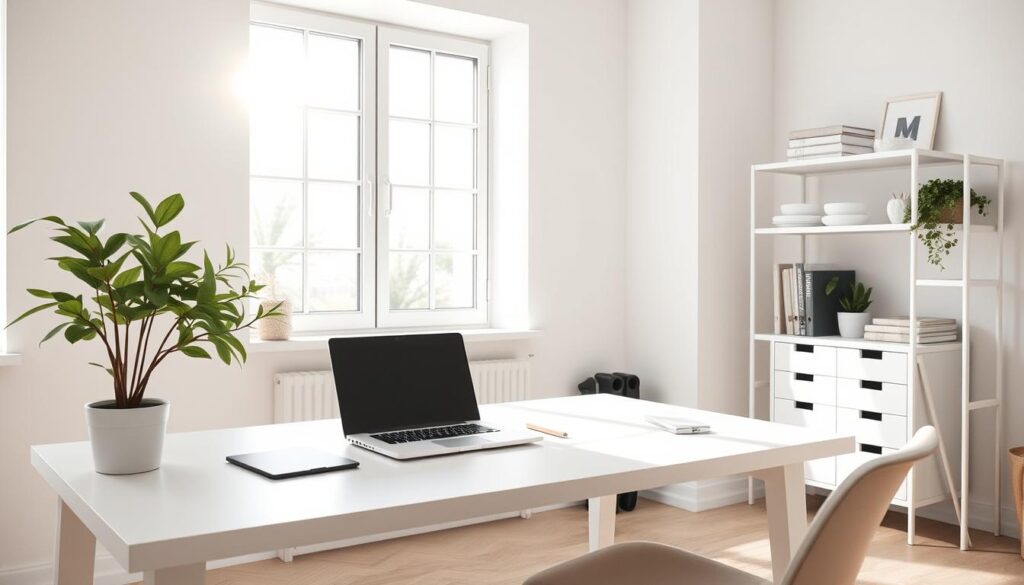
A tidy space lifts minimalist design productivity. It cuts down distractions, letting employees focus better. Moreover, the clean lines and order bring calm, lowering stress and boosting well-being.
Minimalist offices feel open and light, making tight spaces seem bigger. More natural light improves mood and work output. Employees in such spaces are usually happier, leading to better work and morale.
Creativity flourishes in minimalist settings due to less visual clutter. A clean desk area promotes thinking outside the box. Plus, a stylish, modern look draws in the best employees.
The perks of a minimalist workspace also cover adaptability. Simple designs and versatile furniture mean easy changes for new needs. It contributes to a place that’s ever-changing and team-oriented. Staying uncluttered and using smart storage is vital in this.
Clearly, minimalist office benefits are manifold. They include making work and creativity better, enhancing worker happiness, and pulling in talent. This design meets today’s work needs perfectly.
Creating a minimalist office in a small space needs smart decisions. This helps make the area both useful and good-looking. Let’s talk about what you should think about for a tiny office.
Corner desks are great for small offices. They use space that usually goes unused, giving you more room to work. Look for designs that are simple but stylish.
Cory’s monochrome desk setup in Toronto
has a shiny white desk and a pegboard. This helps keep things tidy. Also,
Mattia’s height-adjustable desk in Italy
is not only good-looking but also good for your posture. It’s ideal for small offices.
Foldable furniture is perfect for saving space in a minimalist office. You can put these pieces away when you’re done using them. This keeps your space open and clean. For instance,
Faizur’s compact desk and drawers
are all about being practical without taking up too much space. And,
Logan’s adjustable desk in Florida
shows even small offices can have furniture that moves up and down without losing space.
A well-planned minimalist office in a small space is all about choosing furniture wisely. Using corner desks and foldable furniture helps. Your office will look great and be very functional too.
Using neutral colors in office spaces is not just trendy. It also brings many benefits. A well-picked neutral color palette makes décor timeless and flexible. It’s great for a minimalist color design. Pinterest shows about 534 people recently searched for neutral home office ideas. This shows many people love this calming, stylish option.
Colors like beige, taupe, and white shades create a calm and professional setting. They help with focus and clear thinking. When you use these soothing office colors, you make a place that’s good for work and well-being. This is especially true in a small 10×12 office. There, every part must be useful and simple.
Pinterest’s content on minimalist office ideas has really grown. Over 49+ minimalist home office ideas have been shared for an organized look. This shows how vital neutral colors for office designs are. Interior designer Hannah Kirk points out that mixing neutrals like whites, creams, and beiges with a bit of black adds balance and sophistication. Black brings depth and keeps the space from feeling too plain.
To blend these colors well, here are 12 design tips for a stylish and useful home office:
Neutral colors create a calm, serene workspace, perfect for minimalism. By using these colors, your office will not just look good. It will also boost your productivity and work experience.
Creating a bright workspace is all about using natural light well. Studies find that more light in the office makes employees feel more rested. They also enjoy better quality of life. Enhancing office lighting with smart window design can make the work environment better. This also increases productivity.
Placing windows smartly is key to good light flow in the office. For example, using smart glass panels helps distribute light better. This approach maintains privacy while improving brightness.
“Integrating natural light into office design results in a 40% rise in productivity and a 15% increase in creativity.”
Open office layouts help with the light’s flow since they don’t block light. Also, having less bulky furniture helps spread the natural light more.
Choosing the right window treatments boosts natural lighting. Light curtains and blinds let light in without glare. This keeps offices bright and manages direct sunlight.
Also, shiny surfaces help by reflecting light all over. Using reflection and diffusion methods increases light spread. It also cuts down on energy costs, saving money.
Keeping your workspace clean and organized is key to a productive and efficient minimalist office. It helps get more work done.
We spend one-third of our lives at work. Good work habits aren’t just about being tidy. They’re also about feeling less stressed and doing better in our jobs.
At the heart of minimalist office organization is getting rid of clutter regularly. A lot of what we do might not be needed. Papers often clutter desks the most. Using clean office tips, like scanning documents, can cut down on mess. Most home printers can scan 50 sheets at once, making it easier to keep things digital.
Good decluttering strategies involve automation. Think Standard Operating Procedures (SOPs), checklists, and workflows. These make finishing tasks easier. Automating repetitive work lessens the load and boosts efficiency.
Here are some hands-on tips for a tidy workspace:
A desk with few things on it helps you concentrate and be more productive. Clearing out work areas often and using smart minimalist office organization tactics leads to a smooth, efficient workspace without stress.
In functional minimalist design, every element serves a purpose. This approach keeps workspaces efficient and free from clutter. Gebesa is a leader in creating modern and practical office settings with their simple, sleek furniture. Minimalism is more than just looks; it improves how an office functions and boosts productivity.
Purpose-driven furniture is key in minimalist design. These pieces look good and help keep workspaces tidy. Adjustable desks are now vital in modern offices. They support sitting and standing, promoting health and saving space. This kind of furniture is crucial for anyone wanting to use space wisely.
Creating spaces that serve multiple functions is vital in minimalist design. For example, making meeting areas that also work for individual tasks can save space. This is especially useful in smaller offices that need smart solutions. Gebesa’s furniture is made with these needs in mind, ensuring efficient use of every area while keeping a minimalist look.
Choosing the right storage is key for a tidy and useful workspace. Going for minimalist storage helps keep your space clean and productive. Here are some smart strategies and trends:
About 65% of stylish offices use built-in storage like cubbies and shelves. These are great for clearing clutter while keeping things you need close. For example, built-in shelves look neat and make the most of wall space.
Then, 30% of offices chose vintage or industrial items for a trendy yet practical touch. Freestanding bookshelves, seen in 17% of these spaces, allow for flexible book and decor storage.
Combining open shelves with closed cabinets was a choice in 26% of offices. This setup provides easy access and neat organization. Display shelves, used in 13% of offices, show how to mix looks with usefulness.
Desk drawers were a smart clutter solution in 9% of workspaces. Another 9% benefited from rolling file cabinets and movable storage. This highlights the importance of adaptable storage solutions.
Wall-mounted shelves were crucial in 13% of offices, using wall space wisely. Meanwhile, stylish desk tools and metal details, found in 4% of offices, blend chic with function.
The cloffice trend and cube storage offer creative ways to turn home spots into work areas. Building a desk with drawers and high shelves maximizes cloffice storage. Cabinets around a simple desk also offer a sleek office look.
Lastly, using spaces like kitchens for offices with smart storage can hugely declutter. Looking at unconventional areas and storage types can lead to a neat, minimalist work space.
Choosing a minimalist design for your office boosts your mind and body health. Princeton University’s research found clutter distracts us, hurting our ability to focus. Keeping a workspace neat and tidy is key.
One key benefit of minimalist workspaces is stress reduction. A survey by Office Depot in 2011 showed that 47% of workers think clutter leads to wasted time. Also, 14% said it makes work accumulate, increasing stress. A minimalist space helps by keeping things organized.
The minimalist office advantages also help businesses save money. By using less furniture and decor, costs go down. Minimalist furniture opens up more space, making room for more employees without the extra expense.
Companies that choose minimalist designs attract modern employees. These designs promote teamwork and community, attracting top talent. They also boost communication and creativity, strengthening the team.
Clean, simple workspaces have been shown to increase productivity. Employees work more efficiently in a tidy environment. A neat workplace also clears the mind, helping staff manage stress better.
Opting for a minimalist office design also makes your space look professional and inviting. It shows visitors your company is confident and forward-thinking. This attracts quality clients and workers, boosting your company’s image and success.
Personalizing a minimalist office means mixing your own style with a clean, working space. Adding simple but meaningful things can make these minimalist areas truly yours. For example, think about putting in custom art. Maybe it’s a big picture from a friend’s dad or a matte black lamp from someone close. These special items bring out your personality in the space without making it too busy.
Choosing your furniture and decor carefully also creates a custom minimalist look. Finding second-hand gems, like an old chair or a well-made desk, adds character. You might get a chair, desk, and filing cabinet for just $25.00. Yet, they each tell a story, making the place feel homely and unique. It’s these little details that add meaning and function to a minimalist office.
Adding personal mementos can also make your minimalist office a cozy and inspiring spot. You could hang a photo of your pet or show off your college degrees and favorite books. These personal touches connect you to your work area, improving comfort and efficiency. Studies show that people in tidy, organized places are 83% more motivated. And those with minimalist desks are 30% more likely to finish tasks on time. By carefully adding things that are important to you, your minimalist design will not only look good. It will also feel personal and work well.